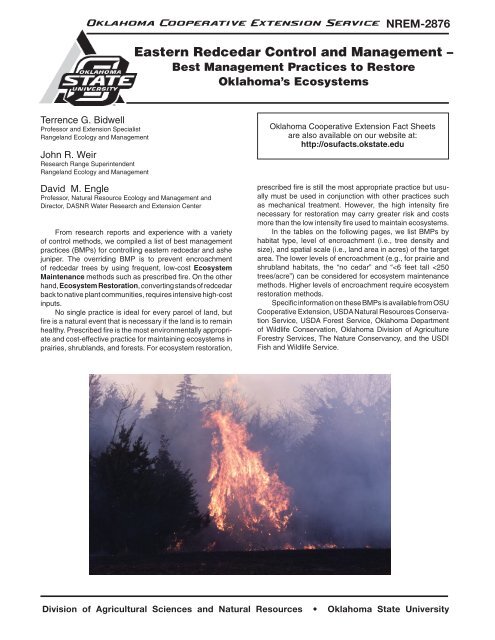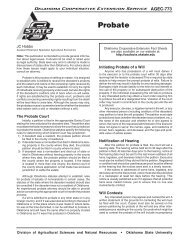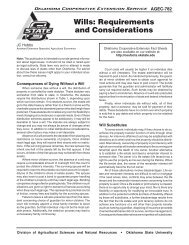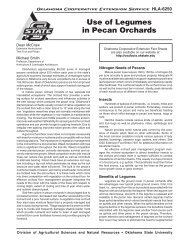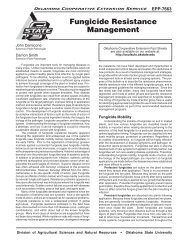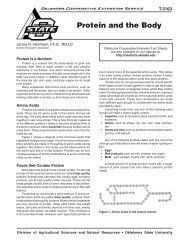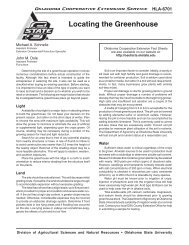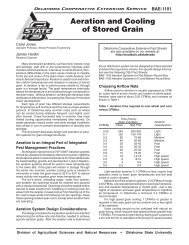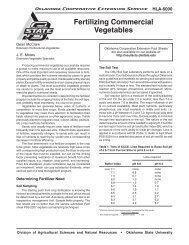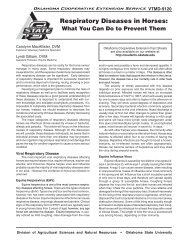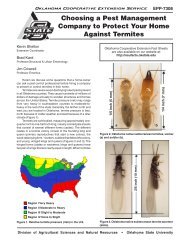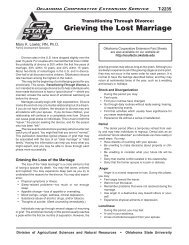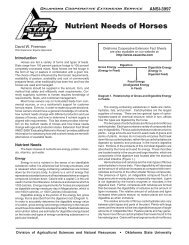Eastern Redcedar Control and Management â - OSU Fact Sheets ...
Eastern Redcedar Control and Management â - OSU Fact Sheets ...
Eastern Redcedar Control and Management â - OSU Fact Sheets ...
Create successful ePaper yourself
Turn your PDF publications into a flip-book with our unique Google optimized e-Paper software.
Oklahoma Cooperative Extension Service<br />
NREM-2876<br />
<strong>Eastern</strong> <strong>Redcedar</strong> <strong>Control</strong> <strong>and</strong> <strong>Management</strong> –<br />
Best <strong>Management</strong> Practices to Restore<br />
Oklahoma’s Ecosystems<br />
Terrence G. Bidwell<br />
Professor <strong>and</strong> Extension Specialist<br />
Rangel<strong>and</strong> Ecology <strong>and</strong> <strong>Management</strong><br />
John R. Weir<br />
Research Range Superintendent<br />
Rangel<strong>and</strong> Ecology <strong>and</strong> <strong>Management</strong><br />
David M. Engle<br />
Professor, Natural Resource Ecology <strong>and</strong> <strong>Management</strong> <strong>and</strong><br />
Director, DASNR Water Research <strong>and</strong> Extension Center<br />
From research reports <strong>and</strong> experience with a variety<br />
of control methods, we compiled a list of best management<br />
practices (BMPs) for controlling eastern redcedar <strong>and</strong> ashe<br />
juniper. The overriding BMP is to prevent encroachment<br />
of redcedar trees by using frequent, low-cost Ecosystem<br />
Maintenance methods such as prescribed fire. On the other<br />
h<strong>and</strong>, Ecosystem Restoration, converting st<strong>and</strong>s of redcedar<br />
back to native plant communities, requires intensive high-cost<br />
inputs.<br />
No single practice is ideal for every parcel of l<strong>and</strong>, but<br />
fire is a natural event that is necessary if the l<strong>and</strong> is to remain<br />
healthy. Prescribed fire is the most environmentally appropriate<br />
<strong>and</strong> cost-effective practice for maintaining ecosystems in<br />
prairies, shrubl<strong>and</strong>s, <strong>and</strong> forests. For ecosystem restoration,<br />
Oklahoma Cooperative Extension <strong>Fact</strong> <strong>Sheets</strong><br />
are also available on our website at:<br />
http://osufacts.okstate.edu<br />
prescribed fire is still the most appropriate practice but usually<br />
must be used in conjunction with other practices such<br />
as mechanical treatment. However, the high intensity fire<br />
necessary for restoration may carry greater risk <strong>and</strong> costs<br />
more than the low intensity fire used to maintain ecosystems.<br />
In the tables on the following pages, we list BMPs by<br />
habitat type, level of encroachment (i.e., tree density <strong>and</strong><br />
size), <strong>and</strong> spatial scale (i.e., l<strong>and</strong> area in acres) of the target<br />
area. The lower levels of encroachment (e.g., for prairie <strong>and</strong><br />
shrubl<strong>and</strong> habitats, the “no cedar” <strong>and</strong> “
Prairie <strong>and</strong> Shrubl<strong>and</strong> Habitats<br />
Scale of Target Area for Maintenance or Restoration (Acres)<br />
Levels<br />
of Encroachment 160 acres or less 160 - 640 acres 640 - 5,000 acres >5,000<br />
Recommended Treatment <strong>and</strong> Cost/Acre<br />
No cedar Fire A $10 Fire A $7 Fire A $5 Fire A $3<br />
250 trees/acre Mech F $160 Mech F $18 Mech F $16 Mech F $16<br />
Treatment Options a<br />
Fire:<br />
Mechanical:<br />
(Do not pile)<br />
Herbicide:<br />
Specific Treatment Descriptions b,c<br />
A - Prescribed burning every 3 to 5 years<br />
B - Prescribed burning with h<strong>and</strong> ignition to kill residual trees<br />
C - Prescribed burning: helicopter ignition with helitorch<br />
D - Prescribed burning: helicopter ignition with helitorch & paraquat<br />
E - Prescribed burning: helicopter ignition with ping-pong machine (DAID)<br />
F - Prescribed burning with h<strong>and</strong> ignition followed by individual tree ignition<br />
G - Prescribed burning with h<strong>and</strong> ignition followed by mechanical<br />
A - H<strong>and</strong> tool (lopper, bow saw, axe, chain saw)<br />
B - Tractor or bobcat with hydraulic clipper<br />
C - Cedar hydraulic saw<br />
D - Bulldozer (pie-shaped saw, push blade)<br />
E - Two bulldozers with 6-foot ball <strong>and</strong> two 100-foot-long anchor chains<br />
F - Mechanical E with follow-up using Fire A<br />
G - Mow or Shred<br />
Velpar or picloram (individual tree treatment)<br />
a<br />
After all initial treatments, prescribed burning should be repeated every 3 to 5 years to maintain the site.<br />
b<br />
Reseeding after treatment is unnecessary, cost prohibitive, <strong>and</strong> usually destructive.<br />
c<br />
Does not include firebreak preparation or maintenance.<br />
NREM-2876-2
Oak-Hickory, Oak-Pine, <strong>and</strong> Post Oak-Blackjack Oak Forest Habitats<br />
Scale of Target Area for Maintenance or Restoration (Acres)<br />
Levels of<br />
Encroachment 160 acres or less 160 - 640 acres 640 - 5,000 acres >5,000<br />
Recommended Treatment <strong>and</strong> Cost/Acre<br />
No cedar Fire A $10 Fire A $7 Fire A $5 Fire A $3<br />
Understory cedar Fire B $10 Fire B $7 Fire B $5 Fire B $5<br />
Mech A $25 Fire C $10 Fire C $10<br />
Herb $40 Fire E $15 Fire E $15<br />
Midstory cedar Fire F $15 Fire F $12 Fire G $17 Fire G $15<br />
Fire G $20 Fire G $17 Fire C $10 Fire C $10<br />
Mech A $25 Mech B $50 Fire E $15 Fire E $15<br />
Mech B $50 Mech C $40<br />
Mech C $40<br />
Overstory cedar Fire D $25 Fire D $25 Fire D $20 Fire D $20<br />
Mech A $25 Mech F $18 Mech F $16 Mech F $16<br />
Mech F $21 Mech G $75<br />
Mech G $100<br />
Treatment Options a<br />
Fire:<br />
Mechanical:<br />
(Do not pile)<br />
Herbicide:<br />
Specific Treatment Descriptions b,c<br />
A - Prescribed burning every 3 to 5 years<br />
B - Prescribed burning with h<strong>and</strong> ignition to kill residual trees<br />
C - Prescribed burning: helicopter ignition with helitorch<br />
D - Prescribed burning: helicopter ignition with helitorch & paraquat<br />
E - Prescribed burning: helicopter ignition with ping-pong machine (DAID)<br />
F - Prescribed burning with h<strong>and</strong> ignition followed by individual tree ignition<br />
G - Prescribed burning with h<strong>and</strong> ignition followed by mechanical<br />
A - H<strong>and</strong> tool (lopper, bow saw, axe, chain saw)<br />
B - Tractor or bobcat with hydraulic clipper<br />
C - Cedar hydraulic saw<br />
D - Bulldozer (pie-shaped saw, push blade)<br />
E - Two bulldozers with 6-foot ball <strong>and</strong> two 100-foot-long anchor chains<br />
F - Mechanical E with follow-up using Fire A<br />
G - Selective dozing followed by Fire A<br />
Velpar or picloram (individual tree treatment)<br />
a<br />
After all initial treatments, prescribed burning should be repeated every 3 to 5 years to maintain the site.<br />
b<br />
Reseeding after treatment is unnecessary, cost prohibitive, <strong>and</strong> usually destructive.<br />
c<br />
Does not include firebreak preparation or maintenance.<br />
NREM-2876-3
Riparian Zone Habitats<br />
Levels of Encroachment<br />
Recommended Treatment <strong>and</strong> Cost/Acre<br />
No cedar Fire A $10<br />
250 trees/acre<br />
Treatment Options a<br />
Fire:<br />
Mechanical:<br />
Herbicide:<br />
Specific Treatment Descriptions b,c<br />
A - Prescribed burning every 3 - 5 years<br />
B - Prescribed burning with h<strong>and</strong> ignition to kill residual trees<br />
C - Prescribed burning: helicopter ignition with helitorch<br />
D - Prescribed burning: helicopter ignition with helitorch & paraquat<br />
E - Prescribed burning: helicopter ignition with ping-pong machine (DAID)<br />
F - Prescribed burning with h<strong>and</strong> ignition followed by individual tree ignition<br />
G - Prescribed burning with h<strong>and</strong> ignition followed by mechanical<br />
A - H<strong>and</strong> tool (lopper, bow saw, axe, chain saw)<br />
B - Tractor or bobcat with hydraulic clipper<br />
C - Cedar hydraulic saw<br />
D - Bulldozer (pie shaped saw, push blade)<br />
E - Two bulldozers with 6-foot ball <strong>and</strong> two 100-foot-long anchor chains<br />
F - Mechanical E with follow-up using Fire A<br />
G - Remove cut trees from riparian zone; follow with Fire A<br />
Velpar or picloram (individual tree treatment)<br />
a<br />
After all initial treatments, prescribed burning should be repeated every 3 to 5 years to maintain the site.<br />
b<br />
Reseeding after treatment is unnecessary, cost prohibitive, <strong>and</strong> usually destructive.<br />
c<br />
Does not include firebreak preparation or maintenance.<br />
Other Considerations<br />
Fire <strong>and</strong> Mechanical – Burn before mechanical treatment.<br />
This will reduce spotfire risks <strong>and</strong> mechanical costs.<br />
Piling Brush – Do not pile redcedar after cutting. Leave<br />
cedar where they lay after cutting to facilitate the fire that will<br />
follow. Piles of burning redcedar give off fire br<strong>and</strong>s that travel<br />
hundreds of feet downwind, causing spot fires.<br />
Reseeding – Once redcedar is cut or burned, it is unnecessary<br />
to reseed the area. Native grasses, forbs, legumes,<br />
<strong>and</strong> woody plants will recover rapidly with adequate rainfall<br />
<strong>and</strong> proper grazing management. Otherwise, recovery will take<br />
longer, but the area will still re-colonize with native plants.<br />
Grazing <strong>Management</strong> – None of the control options<br />
listed will work without proper grazing management. The plant<br />
community cannot be restored without a proper stocking rate<br />
<strong>and</strong> periodic fire, <strong>and</strong> fire cannot be used without adequate<br />
fine fuel (dead grass).<br />
Firebreaks – Refer to <strong>OSU</strong> <strong>Fact</strong> Sheet NREM-2890.<br />
Summary<br />
The invasion of redcedar <strong>and</strong> other fire-intolerant junipers<br />
into prairies, shrubl<strong>and</strong>s, <strong>and</strong> forests is a direct result of fire<br />
suppression. <strong>Redcedar</strong> <strong>and</strong> other junipers are indicators of<br />
poor l<strong>and</strong> management <strong>and</strong> ecosystem dysfunction. Their<br />
presence on the l<strong>and</strong>scape has a negative impact on water<br />
quality, air quality, public safety <strong>and</strong> health, wildlife, <strong>and</strong> agriculture.<br />
It can cause catastrophic wildfires. <strong>Redcedar</strong> has<br />
been identified as the number one conservation concern by the<br />
State Technical Committee for USDA Cost Share Programs.<br />
The Best <strong>Management</strong> Practices described in this fact sheet<br />
can be applied throughout Oklahoma <strong>and</strong> surrounding states.<br />
The prescriptions will fit almost any l<strong>and</strong> management goal<br />
<strong>and</strong> are supported by research findings. A variety of state <strong>and</strong><br />
Federal cost-share programs exist to assist l<strong>and</strong>owners with<br />
juniper control.<br />
Oklahoma State University, in compliance with Title VI <strong>and</strong> VII of the Civil Rights Act of 1964, Executive Order 11246 as amended, Title IX of the Education Amendments of 1972, Americans<br />
with Disabilities Act of 1990, <strong>and</strong> other federal laws <strong>and</strong> regulations, does not discriminate on the basis of race, color, national origin, gender, age, religion, disability, or status as a veteran in<br />
any of its policies, practices, or procedures. This includes but is not limited to admissions, employment, financial aid, <strong>and</strong> educational services.<br />
Issued in furtherance of Cooperative Extension work, acts of May 8 <strong>and</strong> June 30, 1914, in cooperation with the U.S. Department of Agriculture, the Director of Cooperative Extension Service,<br />
Oklahoma State University, Stillwater, Oklahoma. This publication is printed <strong>and</strong> issued by Oklahoma State University as authorized by the Vice President, Dean, <strong>and</strong> Director of the Division<br />
of Agricultural Sciences <strong>and</strong> Natural Resources <strong>and</strong> has been prepared <strong>and</strong> distributed at a cost of 20 cents per copy. 0413 Revised. GH.<br />
NREM-2876-4


